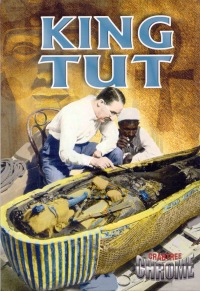| ________________
CM . . .
. Volume XX Number 25. . . .February 28, 2014
excerpt:
So begins the exciting story of the boy pharaoh King Tutankhamun. The discovery of his tomb in 1922 sparked a worldwide Egyptology craze, and the story of King Tut has enthralled and entranced the world. Perhaps a new generation of archeologists will be inspired by reading this book King Tut is yet another title in Crabtree’s “Chrome” series. This series of high interest titles that are designed for middle-years students who are reading at levels L or M (Fontas and Pinnell) or levels 19-20 (Reading Recovery/ PM Benchmark). However, the high quality of the book’s writing, structure and detail make the title appropriate for higher level readers. All the titles in the series are excellent, and this volume on the Pharaoh Tutankhamun is exceptional. It begins with the discovery of the pharaoh’s largely intact tomb but quickly goes on to answer questions on what the word “pharaoh” means and explains how one became a Pharaoh. What was it like to grow up as a royal prince in Egypt, what schooling did he receive, and what did he do for fun? The pharaoh was more than a king; he was also a god and was tasked with keeping the other gods happy through festivals. He also had to keep peace and harmony within the country. Readers learn that Tut spent most of his life preparing for death, and, as soon as he was crowned, work on his tomb began. King Tut lived after the great age of pyramid building, and he was buried in a secret grave in the “Valley of the Kings”. Some pharaohs’ tombs have over 100 rooms, but Tut’s has only four rooms. He died young and was buried in a tomb meant for another person. The book provides details on the elaborate process of mummification and the burial rites of the pharaoh. Of all the pharaohs, why did Tut’s tomb survive intact for 1000s of years? The book tells readers that it was because the tomb was so small, and, given Tut’s short and unremarkable reign, he was forgotten. When the tomb was opened, no one could believe the riches that were uncovered. Over 5000 items were found, and it took 10 years to catalogue the furniture, games, clothes and jewels. The pristine wall paintings and hieroglyphics gave the archaeologists a snapshot of Tut’s short life. All of the items were supposed to be given to the Egyptian government and are on display in the Cairo Museum. Modern science, we learn, is teaching us more about Tut and his life, and the search for more tombs goes on in the Valley of the Kings. Highly Recommended. Ian Stewart teaches at Cecil Rhodes School in Winnipeg, MB.
To comment
on this title or this review, send mail to cm@umanitoba.ca.
Copyright © the Manitoba Library Association. Reproduction for personal
use is permitted only if this copyright notice is maintained. Any
other reproduction is prohibited without permission.
NEXT REVIEW |
TABLE OF CONTENTS FOR THIS ISSUE
- February 28, 2014.
AUTHORS |
TITLES |
MEDIA REVIEWS |
PROFILES |
BACK ISSUES |
SEARCH |
CMARCHIVE |
HOME |
